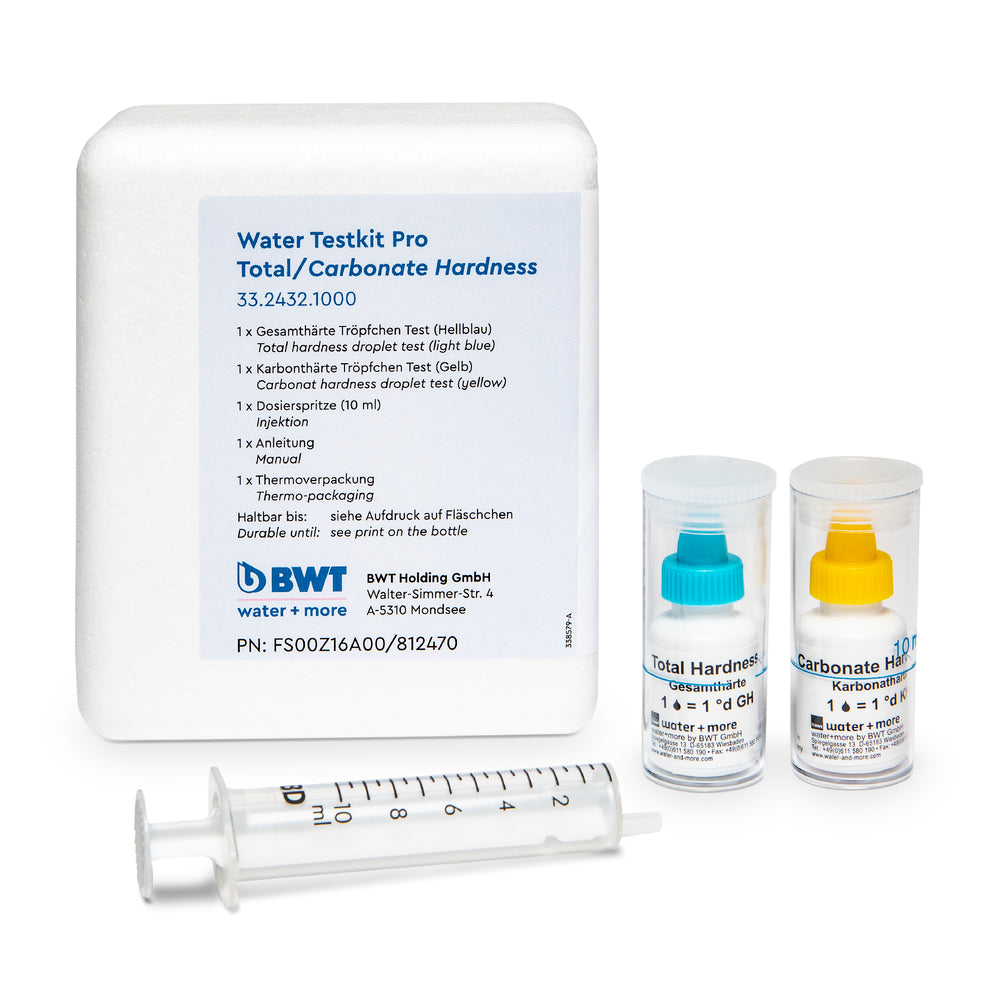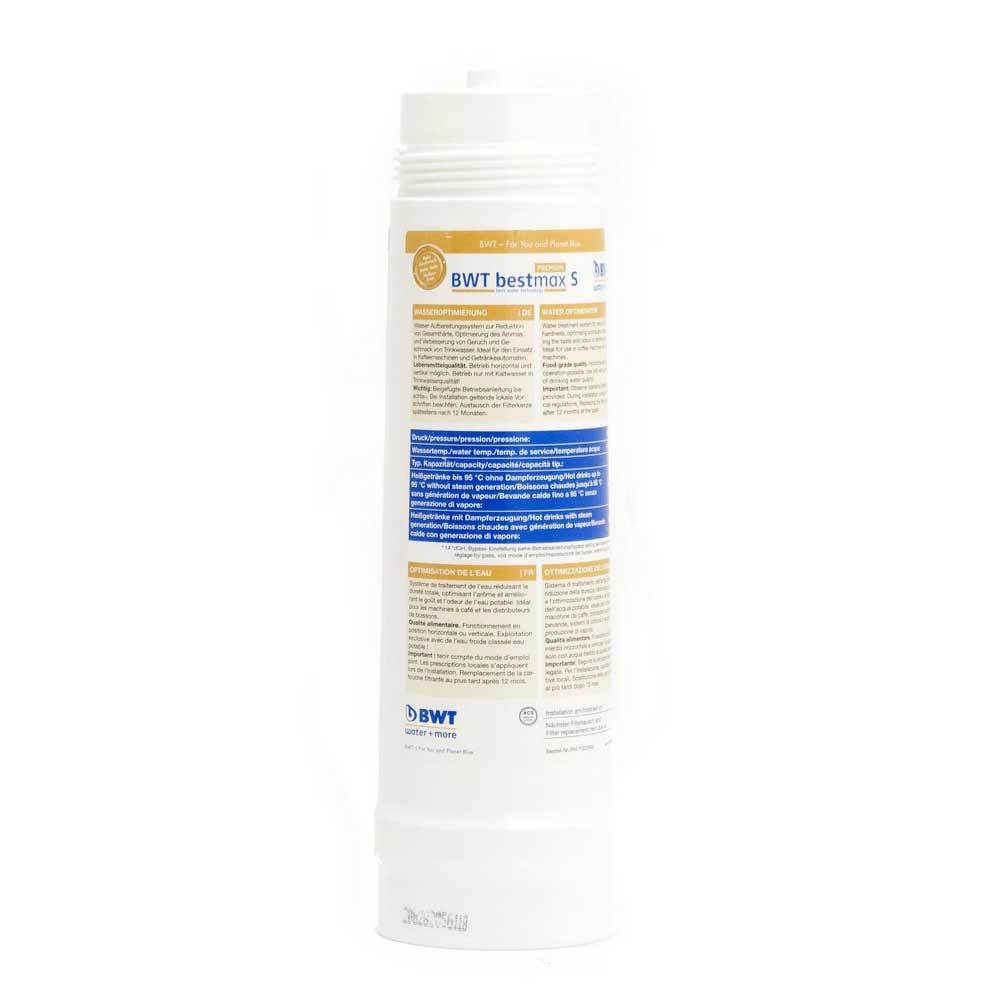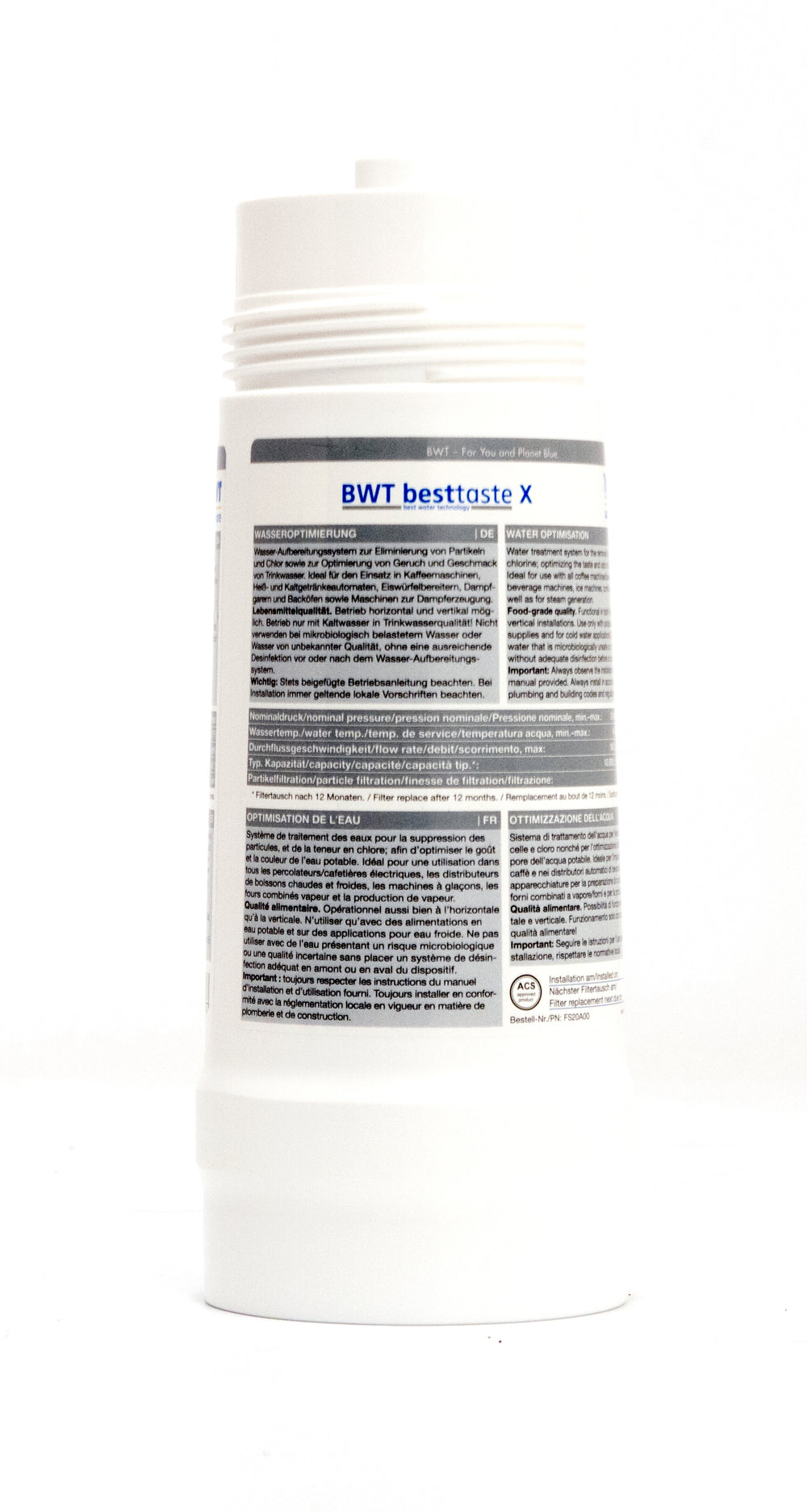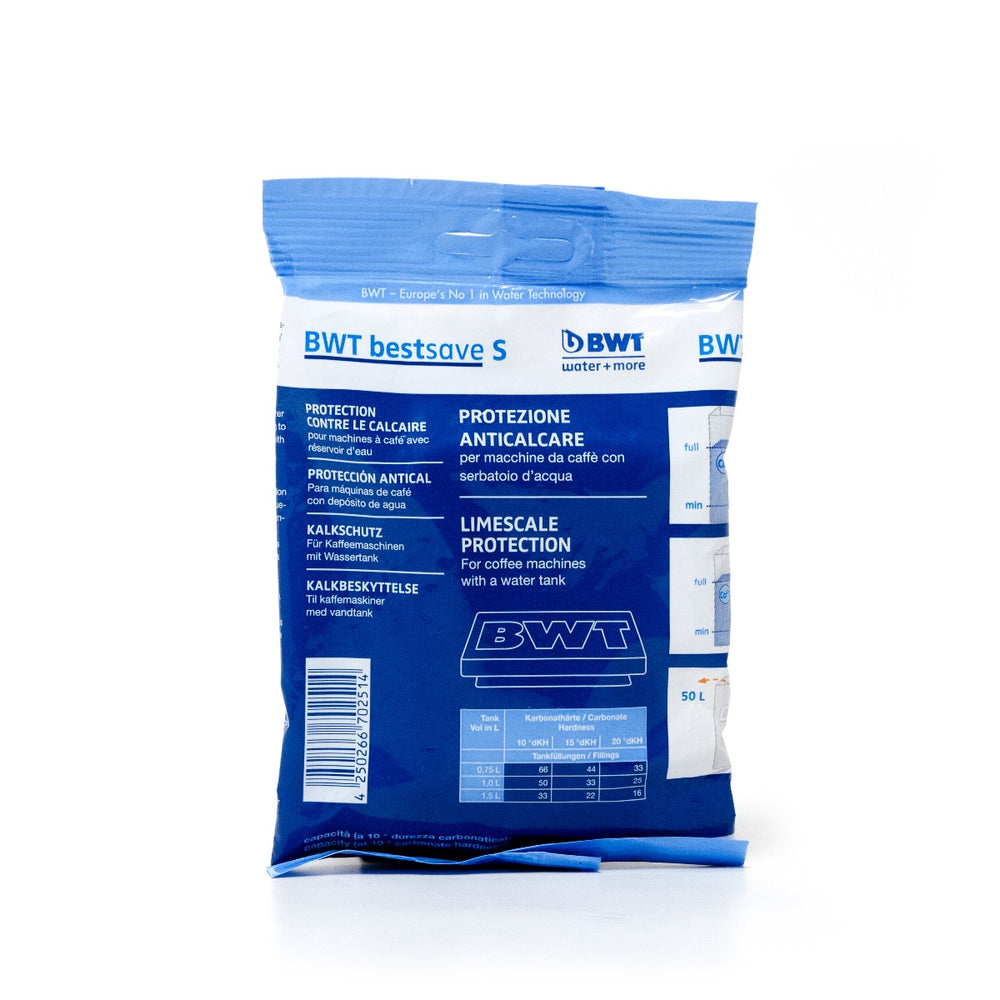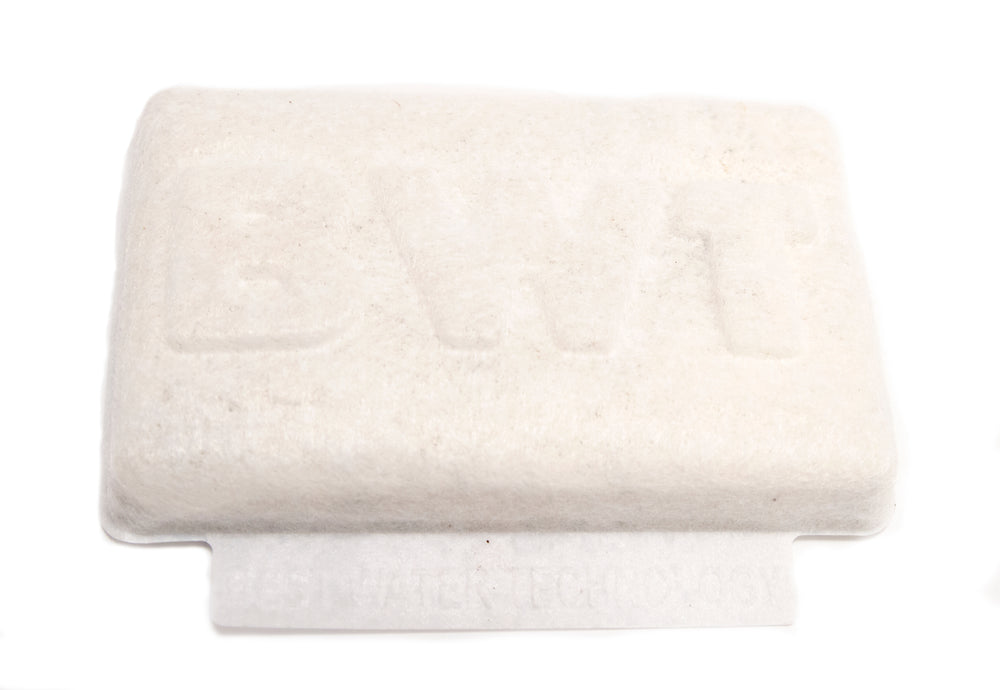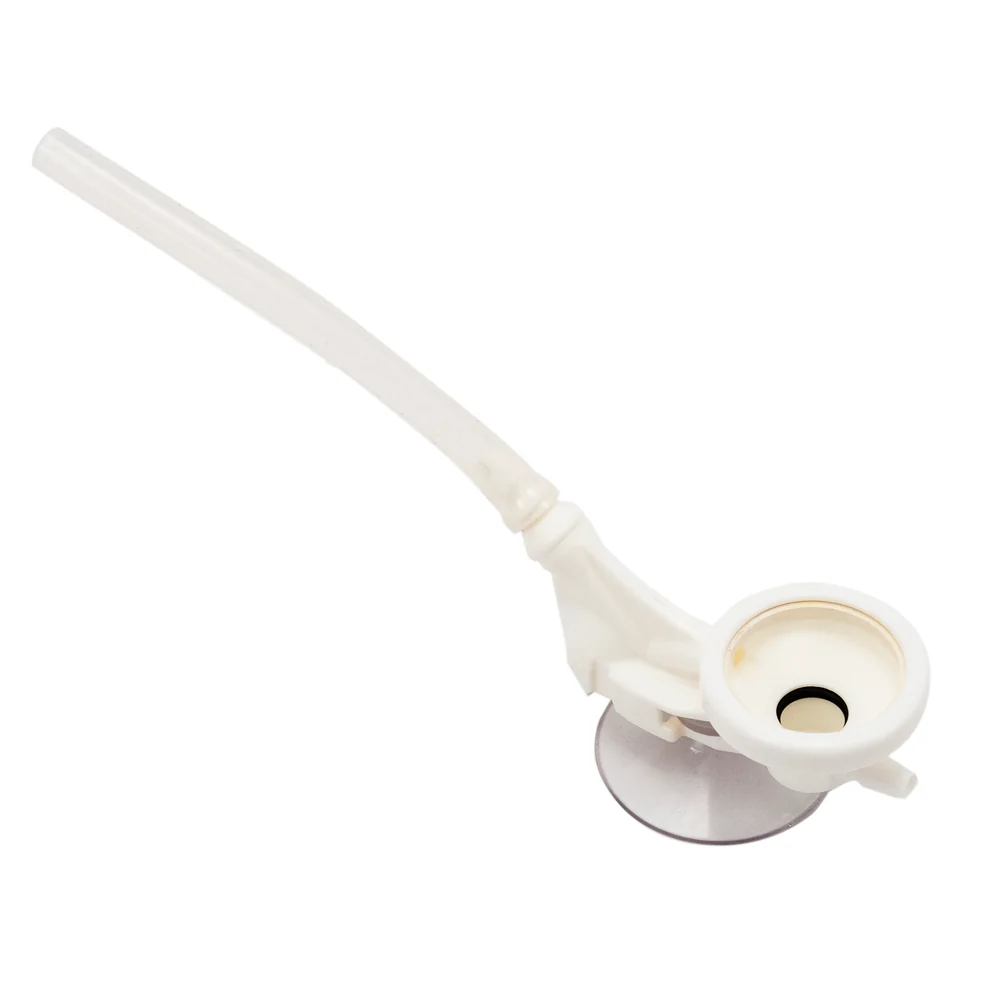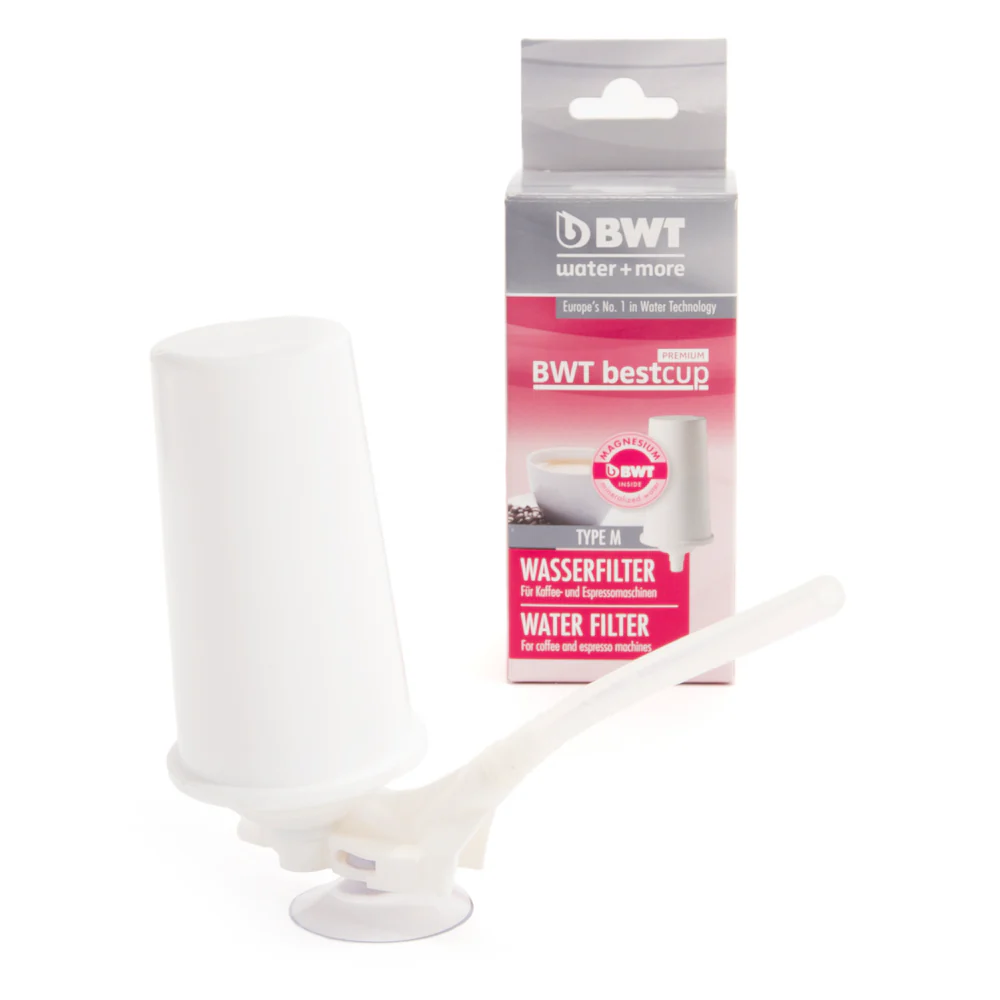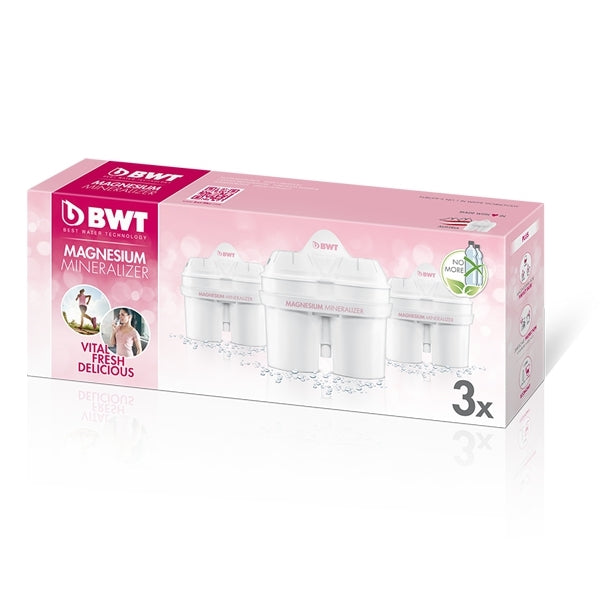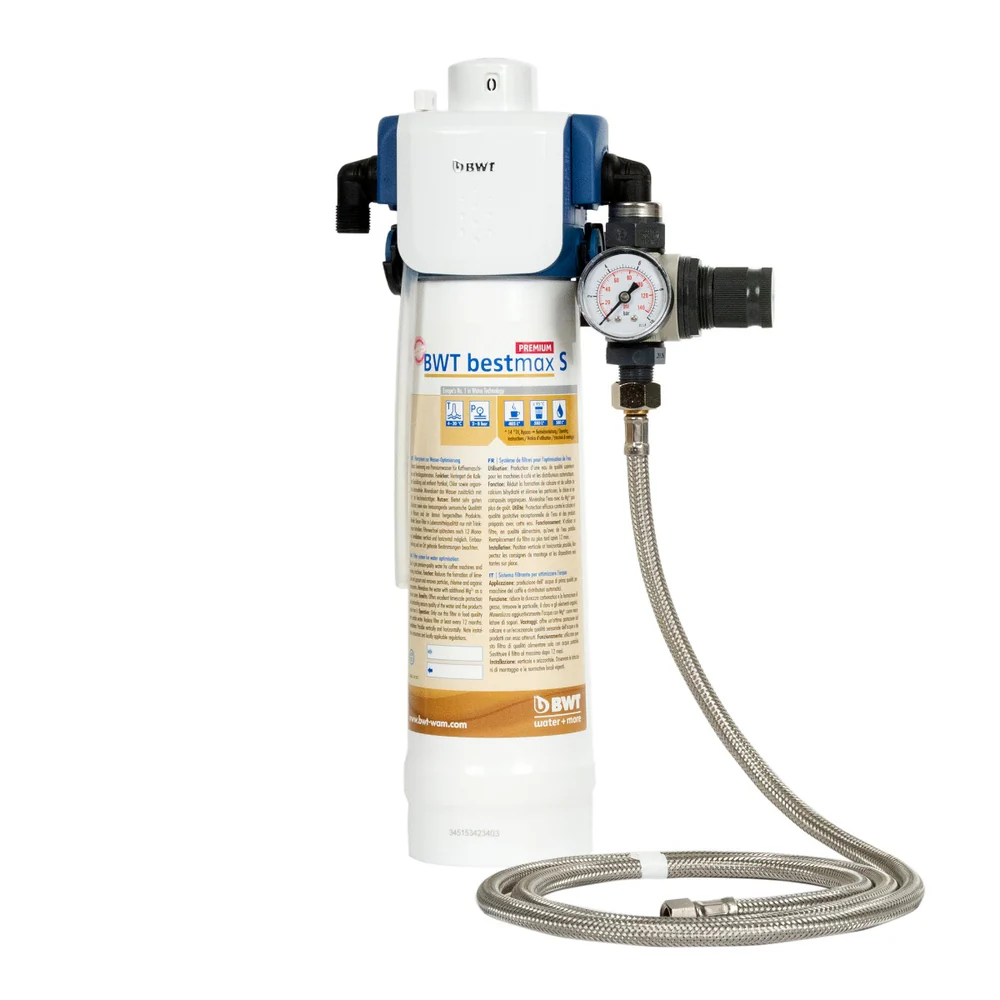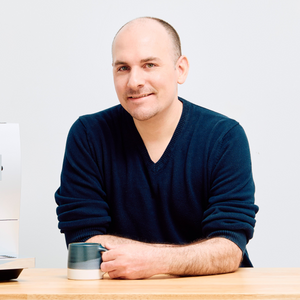BWT Water Filters for Espresso Machines

When it comes to home espresso there are two key factors that make filtering water a necessity: flavor and longevity. If your water tastes off, you don’t want to drink it and this can be applied to anything that you want to cook or brew with it. So, it makes sense that you’d want to screen out some of those contaminants rather than drinking them. The second factor, scale (or more specifically mineral buildup), is a silent killer of espresso machines. Chances are you’ve seen it build up around your faucets, showerheads, and at the bottom of your kettles and pots. For the most part, espresso machines are full of water and pipes.
The scale that you see building up in your bathroom or kitchen will also build up inside of your machine. That’s where water filtration, or water softeners, come into the mix. We’ll be talking about several types of filtration options from BWT including inline (meaning the filter is connected to a water line that is plumbed into your espresso machine) in-tank (meaning the filter sits in the reservoir of your espresso machine), and pitchers (meaning a filter cartridge in the pitcher softens your water). Before getting to the filters themselves though, we’ll take a deeper dive into the topic of water.
How Water Affects the Flavor of Your Coffee
When it comes to brewing coffee and espresso, there are already a ton of factors like temperature, consistency of grind, fines, roast profile, freshness, and of course the origin of the coffee that will impact the flavor in your cup. Adding to the complexity is the fact that your water may contain any number of contaminants (or minerals) that will impact the taste and affect the extraction of your coffee. Even if your water has been softened there’s a chance it may contain other substances that make it onto your palate so it’s vital that you find the best format of water filter for your particular needs. Let’s take a tally of some of the culprits behind bad tasting water.
That’s right, the same chemical used to clean your pool also keeps your drinking water clean. Chlorine is a cost effective additive that helps to protect against bacteria and viruses in the water.
Though it’s not always the case, it’s possible for water to leach minerals from metal used in plumbing. Copper, lead, zinc, and other metals can be pulled from pipes, adding an undesirable metallic taste to your water.
Who knows what else might be in there, but you don’t want it in your cup. Dirt, dust, sand, you name it! No gritty water!
Scale in espresso machines forms layers of calcium deposits that coat the inside of your machine, leading to a deterioration in performance. In your boiler, it impairs the heating of your water and can result in suboptimal temperatures and forces the heating element to use more power. Inside the plumbing, scale constricts flow by narrowing water passages.
Failure to regularly descale your machine can result in large fragments of scale breaking off, loosened by the descaler. These chunks of scale can block water passages and plug small openings, wreaking havoc on your $1,000+ investment. While there are a few different factors that contribute to the buildup of scale, unfiltered calcium content is by far the biggest culprit.
Curious about the rest of the rogue's gallery? Let’s just say that water is incredibly complex and that there’s more than one culprit. According to the Langelier Saturation Index, the following factors all contribute in varying ways to the likelihood of your water to cause scaling:
pH, Temperature, Alkalinity, Cyanuric Acid, Calcium Hardness, and Total Dissolved Solids
There are several ways that you can calculate your water hardness, but when it comes to interpreting results and applying them to BWT’s own literature, the best way is to use one of their water hardness test kits. These kits come with two tests, one of Total Hardness in °d GH and Carbonate Hardness in °d KH which are used for calculating replacement intervals and blend settings for BWT filters. Overall, grabbing a test kit makes it much easier to figure these things out and unless you’re a water scientist or a public works employee, it’s likely your simplest route to protecting your machine.
Distilled and Reverse Osmosis Water
So you might be thinking at this point “who needs minerals anyways?” It may seem intuitive to use distilled or reverse osmosis water in your machine to address the issue of scale. However, this is actually one of the worst things you can do. Your water needs mineral content in order to carry flavors, and some espresso machines even require it in order to detect water in the reservoir. Mineral-deficient water can also leach metal from your boiler and plumbing, corroding your machine!
From a flavor standpoint you also want mineral content in your water to help carry flavor and more complexity to your coffee. To that end, all BWT water filtration solutions that soften water will still have mineral content leftover to prevent flavor from being negatively affected.

Ideal for plumbed prosumer espresso machines, inline filters plumb directly into your water line to filter water before it reaches your machine. BWT has a wide variety of different inline filter cartridges whose application varies based on the quality of the water you’re using. We strongly recommend testing your water with a BWT water hardness test kit prior to purchasing a filter cartridge to ensure that you are properly protecting your machine.
The most common cartridge for water in much of the United States is the Bestmax Premium. It uses a five-layer filtration process to remove contaminants from your water while also exchanging calcium for magnesium via an ion exchanger. This filter is guaranteed to leave you with great tasting water and re-balanced mineral content to protect against scale. Unique to the Bestmax Premium is that the cartridge must be set to one of four blend settings. The setting is based on the hardness of your water and the cartridge includes a chart that lists the blend setting based on your Total Hardness. The easiest way to find it is with one of BWT’s water hardness test kits.
In case you’re curious about how it works, I’ve outlined the steps of the filtration below:
- Particle Pre-Filter - Separation of coarse particles such as sand and rust.
- Activated Carbon Pre-Filter - Elimination of oxidants, protection of the ion exchanger against aging.
- High-performance Ion Exchanger - Removal of hardening substances, adjustment of mineral balance. (replaces calcium with magnesium)
- Activated Carbon Nonwoven - Elimination of organic substances, chlorine, foreign odor, and foreign taste.
- Particle Fine Filter - Separation of fine particles and suspended matter.
According to BWT, when testing your water, if the Total Hardness and alkalinity (Carbonate Hardness) are higher than 7 °D you should use a Bestmax Premium. Based on the results of your test you can then select the appropriate blend setting for your filter cartridge by referring to the instructions included with the cartridge. Failure to properly set your blend setting can result in damage to your machine.
BWT’s Bestprotect filter cartridges are similar to the Bestmax Premium series, but are more specialized. Not only do they prevent the formation of limescale, but Gypsum as well. The Bestprotect also protects against corrosion by helping to maintain a high pH as a buffer against acidity that can result from the presence of chlorides in the water. While there is an ion-exchange present in the Bestprotect to remove Calcium from the water, it does not reintroduce Magnesium like the Bestmax Premium. However, the Bestprotect still features the same layers of filtration as the Bestmax, and will remove all of the same flavor harming impurities.
According to BWT, when testing your water, if the Total Hardness is double your alkalinity (Carbonate Hardness) or higher, you should use a Bestprotect filter instead of a Bestmax Premium.
Gypsum is similar to limescale in that it can form in deposits inside of your machine if your water is not properly treated. It is formed through a combination of Calcium and Sulphate. Because the Bestmax Premium filter cartridges do not run all of the water through the ion-exchange, in water with particularly high total hardness relative to alkalinity there will be enough Calcium left over that can bond with Sulphate which results in Gypsum formation. Gypsum cannot be removed with the same methods as limescale like descaling.
The BWT Besttaste cartridge is intended for flavor treatment only. It does not feature any form of water softening and only removes impurities that would affect flavor such as chlorine, fine particles, organic substances, sand, and rust.
According to BWT, when testing your water, if the Total Hardness and alkalinity (Carbonate Hardness) are between 3° and 6° D you should use a Besttaste.
The BWT Bestmin Premium cartridge is intended for use with water that has either been treated by a reverse osmosis system or that is naturally low in mineral content. It contains a mineralization layer that releases safe amounts of Calcium and Magnesium back into the water to improve flavor, especially for espresso. It’s worth noting that the cartridge also contains a particle pre-filter, activated carbon with silver, and a particle fine filter, so it will remove impurities from low mineral water while at the same time releasing beneficial minerals back into it.
According to BWT, when testing your water, if the Total Hardness and alkalinity (Carbonate Hardness) are between 0° and 3° D you should use a Bestmin Premium. For this reason, this cartridge is often used inline with a reverse osmosis system to remineralize treated water to improve flavor.
If you are planning on connecting your machine to a water line and want to use a BWT filter cartridge, we've got you covered. We've put together packages that include several key components to integrate the cartridge into your water line. The price of the standard "S" size filter cartridge is built into the cost of the package, along with the components below.

BWT’s Besthead FLEX Filter Head is compatible with all inline BWT filtration cartridges including the Bestmax Premium and Bestprotect, Besttaste and Bestmin. The Besthead FLEX connects to your espresso machine through your water line and works in combination with all varieties of BWT cartridges allowing your water to be the best it can be for your coffee or espresso brewing.
The connections on either side of the filter head can easily be removed and swapped for other BWT FLEX connectors for more flexibility when plumbing in. The filter head also features a built-in flush valve and an auto shut-off so you can simply remove the expended filter cartridge and twist in a new one without having to stop the flow of water in your line.

This part is used to reduce incoming water pressure between 2 - 8 bar. Check your machine’s manual to see the ideal line pressure for your particular product.

Used to connect your filter head to all manner of things! Each package includes two of these hoses to take the guesswork out of plumbing your BWT filter head into your water supply. The hose measures four feet long and one side of the hose is female 3/8 BSP while the other is female 3/8 Compression. The 3/8 BSP connection can be connected directly to any threaded male fitting used on BWT’s inline filter accessories.

This last component of filter package is optional but very useful for maintaining your machine. The AQUAmeter is an inline flow meter that you can program with your filter cartridge's maximum capacity. As water flows through the AQUAmeter, it will count down until it reaches zero, at which point it's time to change your filter cartridge. Regardless of your remaining capacity, you should always change out your filter cartridge after one year.

Great for espresso machines that you aren’t going to plumb, these water filters are placed directly into the reservoir to trap and filter contaminants. For those of us who can’t (or aren’t quite ready to) plumb our espresso machines, in-tank filters are a good choice if you just need to filter the water for your machine. BWT’s solution to this conundrum is the Bestsave filter system.
Unpack the filter, give it a rinse, and toss it into your reservoir. The filters require 8-10 hours to remove calcium from untreated water, so you’ll want to get into a routine of refilling your machine overnight so the water has been filtered by the morning. Similar to the Bestmax inline filters, the Bestsaves use an ion exchange that binds calcium ions in the water to prevent scale buildup. They also catch heavy metals like copper and zinc as well as chemicals like chlorine.
It is important to replace the pad as soon as its max capacity is reached, or no later than 2 months, whichever comes first. On the packaging, BWT includes a chart that calculates the total number of tank fills before the filtration capacity is expended. This is determined by your water hardness in °dKH as well as the capacity of your machine’s water reservoir, so you’ll need to know both in order to calculate the total lifespan of your filter.
Water reservoir size is available on our product pages and also in your machine’s manual. To calculate your water hardness, you can consult your local water supplier or use one of the BWT hardness test kits mentioned above.
Use the BWT Bestcup Cartridge Adapter to install a BWT Bestcup filter cartridge in the water tank of your prosumer espresso machine. This adapter is small enough to be place anywhere within the water tank, and comes with an included suction cup as a securing option if needed.
The BWT Bestcup M Package bundles the BWT Bestcup M Premium filter cartridge with a one time purchase filter adapter, allowing you to install the system into the following machines: Bezzera (Hobby 01, BZ10, BZ07), Gaggia (Classic and Classic Pro/Evo/E24), Rancilio (Silvia/Pro/Pro X).
The last water filtration solution we’ll discuss is a filtered water pitcher. BWT offers a 2.6 L water pitcher called the AQUAlizer that can be fitted with filtration cartridges just like a Brita or any other pitchers you might be familiar with. When it comes to BWT’s pitchers and cartridges, the key difference is that they actively soften water and make it safe for use in espresso machines. Their convenience (albeit with the minor wait time for water to filter) make them perfect for super-automatics or machines with smaller water reservoirs.
The patented Magnesium Mineralizing Cartridges filter water and introduce magnesium for a near-neutral pH balance. The cartridges use a combination of fine mesh screens as well as activated carbon which exchanges scale-causing calcium, copper, and lead for magnesium.
We sell two varieties of BWT pitcher cartridges, both mineralize water with magnesium, the only difference is that the “+ Zinc” cartridges add zinc to your water as a dietary supplement. There are other cartridges that BWT makes that can be used in the AQUAlizer, but not all of them soften water. Both cartridges sold by Whole Latte Love soften water to make it safe for use in espresso machines. A last note on the AQUAlizer is that it’s equipped with an illuminated baselight that flashes after each pour. “Pink” means you’re good to go while “Blue” means that it’s time to change your filter cartridge.
$69.99
In addition to preventing scale, flavor contaminants like chlorine, dust, and heavy metals are also removed by the filter cartridges to improve the taste and smell of your water. This is especially nice because the pitcher allows you to use the water for regular drinking or to use for brewing with a drip coffee maker or in a kettle.
Regardless of what kind of equipment you have at home, better tasting water with the proper mineral content will give you better-tasting coffee; this will also cut down on maintenance on your equipment and extend its longevity. At the end of the day, coffee is around 98% water and you owe it to yourself (and your machine) to be brewing with the right stuff.

How To Determine If Your Water Will Cause Scaling in Espresso Machines
-
Complete your Set-Up with the BWT Bestmax Premium Filter Package Bundled for your convenience, the BWT Bestmax Premium Filter Package w/Besthead FLEX has everything yo...
-
Complete your Set-Up with the BWT Bestprotect Filter Package Please Note: If your water's total hardness is double its alkalinity or higher, we recommend using the BWT...
-
Complete your Set-Up with the BWT Besttaste X Filter Package Please Note: The BWT filter heads are threaded with two 3/8" Male BSP fittings. For plumbing into NPT wate...
-
The BWT AQUAlizer with Zinc + Magnesium cartridges is an attractive modern water pitcher with an intuitive baselight to alert you when it's time to change your water filter. When used with BWT Magnesium or Zinc and Magnesium Mineralization Cartridges, the AQUAlizer produces delicious drinking water that will not produce limescale in your espresso machine.
-
The BWT AQUAlizer is an attractive modern water pitcher with an intuitive baselight to alert you when it's time to change your water filter. When used with BWT Magnesium Mineralization Cartridges, the AQUAlizer produces delicious drinking water that will not cause limescale buildup in your espresso machine.
-
BWT Zinc + Magnesium Mineralizer Filter Cartridges Overview BWT's patented magnesium mineralizing technology offers unbeatable improvements to taste in your water and ...
-
BWT Magnesium Mineralizer Filter Cartridges Overview BWT's patented magnesium mineralizing technology offers unbeatable improvements to taste in your water, perfect fo...
-
Complete your Set-Up with the BWT Bestsave M Anti Scale Filter BWT's Bestsave water filter is an in tank filter that protects your machine against scale buildup and he...
-
Complete your Set-Up with the BWT Bestsave S Anti Scale Filter BWT's Bestsave water filter is an in tank filter that protects your machine against scale buildup and he...
-
Complete your Set-Up with the BWT Bestcup M Package The BWT Bestcup M Package bundles the BWT Bestcup M Premium filter cartridge with a one time purchase filter adapte...
 USA
USA

